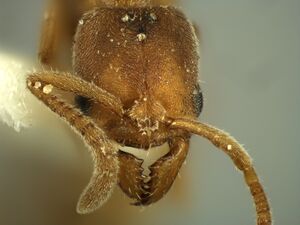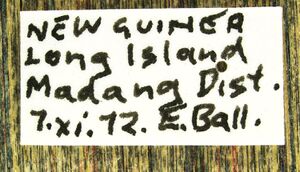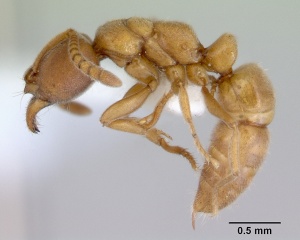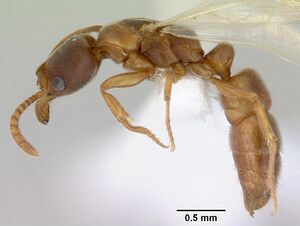Parvaponera darwinii
| Parvaponera darwinii | |
|---|---|

| |
| Scientific classification | |
| Kingdom: | Animalia |
| Phylum: | Arthropoda |
| Class: | Insecta |
| Order: | Hymenoptera |
| Family: | Formicidae |
| Subfamily: | Ponerinae |
| Tribe: | Ponerini |
| Genus: | Parvaponera |
| Species: | P. darwinii |
| Binomial name | |
| Parvaponera darwinii (Forel, 1893) | |
| Subspecies | |
| |
| Synonyms | |
| |
| Common Name | |
|---|---|
| Dahwin-hari-ari | |
| Language: | Japanese |
Parvaponera darwinii is widely distributed from India, through Southeast Asia to Melanesia and northern Australia. Alate queens are often collected at lights. Japanese distribution is apparently limited to the Ryukyus (Terayama, 1985; Japanese Ant Image Database).
| At a Glance | • Limited invasive |
Photo Gallery
Identification
Distribution
Latitudinal Distribution Pattern
Latitudinal Range: 30.7448° to -9.46°.
| North Temperate |
North Subtropical |
Tropical | South Subtropical |
South Temperate |
- Source: AntMaps
Distribution based on Regional Taxon Lists
Afrotropical Region: Chad, Ivory Coast, Mali.
Australasian Region: Australia (type locality).
Indo-Australian Region: Borneo, Indonesia, Malaysia, New Guinea, Philippines, Singapore, Solomon Islands.
Oriental Region: India (type locality), Myanmar (type locality), Sri Lanka, Vietnam.
Palaearctic Region: China, Israel, Japan, Malta.
Japan (Nansei Is (Okinawa I., Iriomote I.)).
Distribution based on AntMaps
Distribution based on AntWeb specimens
Check data from AntWeb
Countries Occupied
| Number of countries occupied by this species based on AntWiki Regional Taxon Lists. In general, fewer countries occupied indicates a narrower range, while more countries indicates a more widespread species. |

|
Estimated Abundance
| Relative abundance based on number of AntMaps records per species (this species within the purple bar). Fewer records (to the left) indicates a less abundant/encountered species while more records (to the right) indicates more abundant/encountered species. |

|
Biology
Castes
       
| |
| . | Owned by Museum of Comparative Zoology. |
Images from AntWeb
   
| |
| Worker. Specimen code casent0172437. Photographer April Nobile, uploaded by California Academy of Sciences. | Owned by ANIC, Canberra, Australia. |
   
| |
| Queen (alate/dealate). Specimen code casent0172438. Photographer April Nobile, uploaded by California Academy of Sciences. | Owned by ANIC, Canberra, Australia. |
       
| |
| Queen (alate/dealate). Specimen code casent0476550. Photographer Jean Claude Rakotonirina, uploaded by California Academy of Sciences. | Owned by CAS, San Francisco, CA, USA. |
Nomenclature
The following information is derived from Barry Bolton's Online Catalogue of the Ants of the World.
- darwinii. Belonopelta darwinii Forel, 1893d: 460 (q.) AUSTRALIA (Northern Territory).
- Type-material: holotype queen.
- Type-locality: Australia: Port Darwin (J.J. Walker).
- Type-depository: MHNG.
- [Misspelled as dawini by Santschi, 1914d: 318.]
- Terayama, 1990: 897 (w.).
- Combination in Pachycondyla (Pseudoponera): Emery, 1900d: 668;
- combination in Pseudoponera: Bingham, 1903: 93;
- combination in Euponera (Trachymesopus): Emery, 1911d: 86;
- combination in Trachymesopus: Wilson, 1958d: 353;
- combination in Pachycondyla: Brown, in Bolton, 1995b: 304;
- combination in Parvaponera: Schmidt, C.A. & Shattuck, 2014: 200.
- Status as species: Forel, 1899d: 320; Emery, 1900d: 668; Emery, 1901a: 46; Emery, 1901f: 113; Bingham, 1903: 93; Emery, 1911d: 86; Santschi, 1914d: 318; Wheeler, W.M. 1919e: 56; Chapman & Capco, 1951: 65; Wilson, 1958d: 353; Collingwood, 1962: 224; Taylor & Brown, 1985: 52; Taylor, 1987a: 80; Morisita, et al. 1989: 20; Terayama, 1990: 897; Bolton, 1995b: 304; Schembri & Collingwood, 1995: 153; Xu, 1995b: 104 (in key); Tiwari, 1999: 30; Imai, et al. 2003: 211; Lin & Wu, 2003: 67; Framenau & Thomas, 2008: 80; Terayama, 2009: 106 (in key); Vonshak, et al. 2009: 46; Zhou & Ran, 2010: 108; Guénard & Dunn, 2012: 60; Sarnat, et al. 2013: 73; Borowiec, L. 2014: 141 (see note in bibliography) ; Bharti, Guénard, et al. 2016: 53.
- Senior synonym of indica Emery: Lin & Wu, 2003: 68; Terayama, 2009: 104.
- Senior synonym of indica Forel: Lin & Wu, 2003: 68 (by implication); Terayama, 2009: 104 (by implication).
- Senior synonym of lamarki: Brown, 1963: 6; Bolton, 1995b: 304.
- Senior synonym of rufotestaceus: Brown, 1963: 6; Bolton, 1995b: 304.
- Distribution:
- Afrotropical: Congo.
- Austral: Australia,
- Malesian: Christmas I., Indonesia (Irian Jaya, Java, Sumatra), Malaysia (Peninsula, Sabah, Sarawak), Papua New Guinea, Philippines (Luzon, Negos), Singapore, Solomon Is, Vanuatu.
- Oriental: China, India, Japan, Myanmar, Taiwan, Thailand.
- Palaearctic: Malta, Israel.
- Current subspecies: nominal plus africana, madecassa.
- indica. Belonopelta darwini var. indica Emery, 1899f: 268 (footnote) (q.) MYANMAR.
- Type-material: holotype queen.
- Type-locality: Myanmar: “Alta Birmania” (Doherty).
- Type-depository: MSNG.
- Combination in Pachycondyla (Pseudoponera): Emery, 1901a: 46;
- combination in Euponera (Pseudoponera): Forel, 1901f: 343;
- combination in Pseudoponera: Bingham, 1903: 93;
- combination in Euponera (Trachymesopus): Emery, 1911d: 86;
- combination in Pachycondyla: Brown, in Bolton, 1995b: 306;
- combination in Parvaponera: Schmidt, C.A. & Shattuck, 2014: 200.
- Subspecies of dawinii: Forel, 1901f: 343; Forel, 1901h: 46; Forel, 1911a: 23; Forel, 1911d: 382; Emery, 1911d: 86; Forel, 1913f: 184; Forel, 1913k: 8; Viehmeyer, 1916a: 114; Viehmeyer, 1916b: 284; Wheeler, W.M. 1919e: 56; Wheeler, W.M. 1923b: 1; Wheeler, W.M. & Chapman, 1925: 68; Santschi, 1928h: 122; Wheeler, W.M. 1929g: 59; Wheeler, W.M. 1930h: 60; Chapman & Capco, 1951: 65; Baltazar, 1966: 244; Bolton, 1995b: 306; Pfeiffer, et al. 2011: 57.
- Junior synonym of darwinii: Lin & Wu, 2003: 68; Teryama, 2009: 104.
- indica. Belonopelta darwinii var. indica Forel, 1900d: 320 (q.) INDIA (no state data).
- Type-material: syntype queens (number not stated).
- Type-localities: India: Poona (Wroughton), and Kanara (Wroughton).
- Type-depository: MHNG.
- [Unresolved junior primary homonym of Belonopelta darwini var. indica Emery, 1899f: 268.]
- Subspecies of darwinii: Bingham, 1903: 93.
- Junior synonym of indica Emery: Emery, 1911d: 86; Bolton, 1995b: 306.
- Junior synonym of darwinii: Lin & Wu, 2003: 68 (by implication); Teryama, 2009: 104 (by implication).
- lamarki. Euponera (Trachymesopus) lamarki Santschi, 1913c: 303 (q.) CONGO.
- Type-material: holotype queen.
- Type-locality: Congo: Dar Banda méridional (Decorse).
- Type-depository: NHMB.
- Status as species: Wheeler, W.M. 1922a: 779; Santschi, 1930a: 54.
- Junior synonym of darwinii: Brown, 1963: 6; Bolton, 1995b: 306.
- rufotestaceus. Cryptopone rufotestaceus Donisthorpe, 1943b: 197 (q.) INDIA (Kerala).
- Type-material: 3 syntype queens.
- Type-locality: India: Travancore, Tenmalai, 500-800 ft, 11-17.x.1938, Colombo Museum Expd. (no collector’s name).
- Type-depository: BMNH.
- Combination in Trachymesopus: Wilson, 1958d: 361 (footnote).
- Status as species: Chapman & Capco, 1951: 53; Wilson, 1958d: 361 (footnote); Tiwari, 1999: 30 (error).
- Junior synonym of darwinii: Brown, 1963: 6; Bolton, 1995b: 309.
Type Material
- Belonopelta darwinii Forel, 1893: Holotype, queen, Darwin (as Port Darwin), Northern Territory, Australia, Musee d'Histoire Naturelle Genève.
Description
Queen
Bingham (1903) - Brownish yellow all over, on the head and thorax; head. in some specimens darkening thorax and abdomen minutely and densely punctate, rugulose and subopaque; entirely covered with very fine short silky yellow pubescence, as in P. amblyops most conspicuous on the head in front; pilosity fairly abundant, long and soft towards the apex of the abdomen. Head without the mandibles rectangular, nearly square, slightly and broadly emarginate posteriorly, the sides slightly convex, the posterior and anterior margins about the same breadth; mandibles long, triangular, the masticatory margin armed with 7 teeth alternately large and small: clypeus with the median lobe shorter and less pronounced than in P. amblyops; eyes and ocelli large and conspicuous, the former nearly touching the bases of the mandibles. Thorax, legs, pedicel and abdomen with the characters as in the genus.
Length: 4.5 mm
References
- Bingham, C. T. 1903. The fauna of British India, including Ceylon and Burma. Hymenoptera, Vol. II. Ants and Cuckoo-wasps. London: Taylor and Francis, 506 pp. (page 93, Combination in Pseudoponera)
- Borowiec, L. 2014. Catalogue of ants of Europe, the Mediterranean Basin and adjacent regions (Hymenoptera: Formicidae). Genus (Wroclaw) 25(1-2): 1-340.
- Branstetter, M.G., Longino, J.T. 2022. UCE phylogenomics of New World Cryptopone (Hymenoptera: Formicidae) elucidates genus boundaries, species boundaries, and the vicariant history of a temperate–tropical disjunction. Insect Systematics & Diversity 6(1): 6:1-23 (doi:10.1093/isd/ixab031).
- Brown, W. L., Jr. 1963a. Characters and synonymies among the genera of ants. Part III. Some members of the tribe Ponerini (Ponerinae, Formicidae). Breviora 190: 1-10 (page 6, Senior synonym of lamarki and rufotestaceus)
- Brown, W. L., Jr. 1995a. [Untitled. Taxonomic changes in Pachycondyla attributed to Brown.] Pp. 302-311 in: Bolton, B. A new general catalogue of the ants of the world. Cambridge, Mass.: Harvard University Press, 504 pp. (page 304, Combination in Pachycondyla)
- Emery, C. 1900d. Formiche raccolte da Elio Modigliani in Sumatra, Engano e Mentawei. [part]. Ann. Mus. Civ. Stor. Nat. 40[=(2(20): 689-720 (page 688, Combination in Pachycondyla (Pseudoponera))
- Emery, C. 1901b. Notes sur les sous-familles des Dorylines et Ponérines (Famille des Formicides). Ann. Soc. Entomol. Belg. 45: 32-54 (page 46, Combination in Pachycondyla (Pseudoponera))
- Emery, C. 1911e. Hymenoptera. Fam. Formicidae. Subfam. Ponerinae. Genera Insectorum 118: 1-125 (page 86, Combination in Euponera (Trachymesopus))
- Esteves, F.A., Fisher, B.L. 2021. Corrieopone nouragues gen. nov., sp. nov., a new Ponerinae from French Guiana (Hymenoptera, Formicidae). ZooKeys 1074, 83–173 (doi:10.3897/zookeys.1074.75551).
- Forel, A. 1893f. Nouvelles fourmis d'Australie et des Canaries. Ann. Soc. Entomol. Belg. 37: 454-466 (page 460, queen described)
- Schmidt, C.A. & Shattuck, S.O. 2014. The higher classification of the ant subfamily Ponerinae (Hymenoptera: Formicidae), with a review of ponerine ecology and behavior. Zootaxa 3817, 1–242 (doi:10.11646/zootaxa.3817.1.1).
- Terayama, M. 1990b. Discovery of worker caste in Trachymesopus darwinii (Forel, 1893). Jpn. J. Entomol. 58: 897-898 (page 897, worker described)
- Wang, W.Y., Soh, E.J.Y., Yong, G.W.J., Wong, M.K.L., Benoit Guénard, Economo, E.P., Yamane, S. 2022. Remarkable diversity in a little red dot: a comprehensive checklist of known ant species in Singapore (Hymenoptera: Formicidae) with notes on ecology and taxonomy. Asian Myrmecology 15: e015006 (doi:10.20362/am.015006).
- Wilson, E. O. 1958g. Studies on the ant fauna of Melanesia III. Rhytidoponera in western Melanesia and the Moluccas. IV. The tribe Ponerini. Bulletin of the Museum of Comparative Zoology 119: 303-371 (page 353, Combination in Trachymesopus)
References based on Global Ant Biodiversity Informatics
- Bolton, B. 1998. A preliminary analysis of the ants of the Pasoh Forest Reserve. Pp. 84-95 in: Lee, S. S.; Dan, Y. M.; Gauld, I. D.; Bishop, J. (eds.) Conservation, management and development of forest resources. Proceedings of the Malaysia-United Kingdom Programme Workshop 21-24 October 1996. Kuala Lumpur: International Institute for Environment and Development, 392 pp.: 84-95
- Chapman, J. W., and Capco, S. R. 1951. Check list of the ants (Hymenoptera: Formicidae) of Asia. Monogr. Inst. Sci. Technol. Manila 1: 1-327
- Collingwood C. A. 1962. Some ants (Hym. Formicidae) from north-east Asia. Entomologisk Tidskrift 83: 215-230.
- Dad J. M., S. A. Akbar, H. Bharti, and A. A. Wachkoo. 2019. Community structure and ant species diversity across select sites ofWestern Ghats, India. Acta Ecologica Sinica 39: 219–228.
- Dias R. K. S. 2002. Current knowledge on ants of Sri Lanka. ANeT Newsletter 4: 17- 21.
- Emery C. 1901. Ameisen gesammelt in Ceylon von Dr. W. Horn 1899. Deutsche Entomologische Zeitschrift 1901: 113-122.
- Emery C. Formiche raccolte da Elio Modigliani in Sumatra, Engano e Mentawei. Annali del Museo Civico di Storia Naturale 40: 661-722.
- Emery, C. "Formiche raccolte da Elio Modigliani in Sumatra, Engano e Mentawei." Annali del Museo Civico di Storia Naturale Giacomo Doria (Genova) (2) 20, no. 40 (1900): 661-722.
- Forel A. 1901. Formiciden des Naturhistorischen Museums zu Hamburg. Neue Calyptomyrmex-, Dacryon-, Podomyrma- und Echinopla-Arten. Mitt. Naturhist. Mus. Hambg. 18: 43-82.
- Framenau V.W., and M.L. Thomas. 2008. Ants of Christmas Island (Indian Ocean); identification and distribution. Records of the Western Australian Museum 25: 45-85.
- Guénard B., and R. R. Dunn. 2012. A checklist of the ants of China. Zootaxa 3558: 1-77.
- Hua Li-zhong. 2006. List of Chinese insects Vol. IV. Pages 262-273. Sun Yat-sen university Press, Guangzhou. 539 pages.
- Janda M., G. D. Alpert, M. L. Borowiec, E. P. Economo, P. Klimes, E. Sarnat, and S. O. Shattuck. 2011. Cheklist of ants described and recorded from New Guinea and associated islands. Available on http://www.newguineants.org/. Accessed on 24th Feb. 2011.
- Li Z.h. 2006. List of Chinese Insects. Volume 4. Sun Yat-sen University Press
- Terayama M. 1985. Trachymesopus darwini (FOREL), Pentastruma sauteri FOREL and Rhopalomastix sp. Were collected from the Nansei Islands; tribe Melissotarsini is new to Japan. Ari 13: 8
- Terayama M. 1990. Discovery of worker caste in Trachymesopus darwinii (Forel, 1893). Japanese Journal of Entomology 58: 897-898
- Terayama M. 1992. Structure of ant communities in East Asia. A. Regional differences and species richness. Bulletin of the Bio-geographical Society of Japan 47: 1-31.
- Terayama M. 2009. A synopsis of the family Formicidae of Taiwan (Insecta: Hymenoptera). Research Bulletin of Kanto Gakuen University. Liberal Arts 17:81-266.
- Terayama M., S. Kubota, and K. Eguchi. 2014. Encyclopedia of Japanese ants. Asakura Shoten: Tokyo, 278 pp.
- Terayama Mamoru. 2009. A synopsis of the family Formicidae of Taiwan (Insecta, Hymenoptera). The Research Bulletin of Kanto Gakuen University 17: 81-266.
- Terayama, M. 2009. A synopsis of the family Formicidae of Taiwan (Insecta; Hymenoptera). The Research Bulletin of Kanto Gakuen University 17: 81-266.
- Tiwari R. N. 1999. Taxonomic studies on ants of southern India (Insecta: Hymenoptera: Formicidae). Memoirs of the Zoological Survey of India 18(4): 1-96.
- Tiwari, R.N. 1999. Taxonomic studies on ants of southern India (Insecta: Hymenoptera: Formicidae). Memoirs of the Zoological Survey of India 18(4):1-96
- Wheeler W. M. 1922. Ants of the American Museum Congo expedition. A contribution to the myrmecology of Africa. IX. A synonymic list of the ants of the Malagasy region. Bulletin of the American Museum of Natural History 45: 1005-1055
- Wilson E. O. 1958. Studies on the ant fauna of Melanesia III. Rhytidoponera in western Melanesia and the Moluccas. IV. The tribe Ponerini. Bulletin of the Museum of Comparative Zoology 119: 303-371.
- Wilson Edward O. 1959. Adaptive Shift and Dispersal in a Tropical Ant Fauna. Evolution 13(1): 122-144
- Yamane S., S. Ikudome, and M. Terayama. 1999. Identification guide to the Aculeata of the Nansei Islands, Japan. Sapporo: Hokkaido University Press, xii + 831 pp. pp, 138-317.
- Yamane S.; Ikudome, S.; Terayama, M. 1999. Identification guide to the Aculeata of the Nansei Islands, Japan. Sapporo: Hokkaido University Press, xii + 831 pp. pp138-317.
- Zryanin V. A. 2011. An eco-faunistic review of ants (Hymenoptera: Formicidae). In: Structure and functions of soil communities of a monsoon tropical forest (Cat Tien National Park, southern Vietnam) / A.V. Tiunov (Editor). – M.: KMK Scientific Press. 2011. 277 р.101-124.


